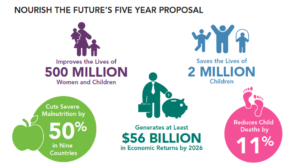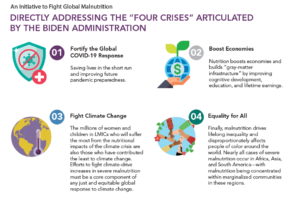

“The COVID-19 pandemic disrupted — and continues to disrupt — all of the systems related to good nutrition. From food and health, to social protection programmes for families who are suffering financially. This means that millions of children are still struggling to access the nutritious and safe diets they need to grow, develop and learn to their full potential.”
These are the remarks from UNICEF Executive Director Henrietta Fore at the launch of the State of Food Security and Nutrition in the World report in July on the need to tackle child malnutrition in the hardest hit countries.
Malnutrition is the leading cause of child deaths worldwide, taking the lives of more kids under the age of 5 each year than AIDS, malaria, and tuberculosis combined. Malnutrition deprives bodies of essential resources, weakens immune systems, and leaves young children up to 15 times more likely to die from common infectious diseases, including COVID-19.
The world has witnessed the significant and tragic loss of more than 3 million people due COVID-19 over the past year. What hasn’t made headlines is the more than 3 million children who have died from malnutrition during that same time, and the tens of millions more who will face lifelong consequences after suffering from malnutrition during critical periods of their growth. Now, experts predict that the COVID-19 pandemic could cause up to a 50% rise in severe malnutrition — 10,000 more child deaths each month as a result of pandemic-related disruptions in essential services.
It is time for this global tragedy to make headlines and for the world to act. We need political will and increased financing to put the proven, cost-effective tools that exist to prevent and treat malnutrition into action. In that spirit, a group of global health and nutrition experts recently launched an ambitious set of recommendations to do just that – to save millions of children’s lives and improve millions more for mothers and children globally by investing in global malnutrition. A new proposal for U.S. Government, Nourish the Future, would reduce severe child malnutrition in focus countries by 40 to 50 percent and reduce child deaths in those countries by up to 11 percent, one of the most dramatic reductions in child deaths since 1990.
Nourish the Future proposes to scale up the most lifesaving nutrition interventions in focus countries with high burdens of child malnutrition. Health and food systems—the two main vehicles for combating malnutrition—must work in harmony to fully eliminate severe malnutrition. Nourish the Future offers a strategy to strengthen these systems and integrate existing, siloed, vertical programming while working in partnership with country governments (accelerating national nutrition plans), affected communities, and local and international organizations.

Through health systems, Nourish the Future proposes integrating key nutrition interventions (often known as the ‘Power 4’ – prenatal vitamins, breastfeeding support, vitamin A supplementation, and emergency therapeutic food) into national health systems and community health worker protocols; improving United Nations leadership on preventing and treating malnutrition; doubling the global supply of products to treat the most severe forms of malnutrition; and bundling nutrition interventions with child immunization campaigns so no child is left behind.
Through food systems, Nourish the Future proposes supporting value chains for safer, more nutritious foods with less food loss and waste; improving the year-round consumption of safe, affordable, nutritious food for women and children; empowering female farmers with access to investment capital and supportive peer groups; expanding large-scale food fortification; and scaling up private-sector solutions to global malnutrition.

This level of ambition is not unprecedented. Former UNICEF Executive Director Jim Grant oversaw a groundbreaking UNICEF child survival campaign between 1980 and 1990. His leadership of UNICEF and back-to-basics approach drove an increase in worldwide child immunization rates for six diseases from approximately 16-21 percent to nearly 80 percent. The U.S. Government has also led transformative global health programming in past decades, saving millions of lives through programs such as the President’s Emergency Plan for AIDS Relief and the President’s Malaria Initiative. With relatively modest investment, similar progress can be achieved by implementing high-impact nutrition programming.
The recent release of the 2021 State of Food Security and Nutrition Report has brought the long-standing malnutrition crisis into focus: Globally, the world is not on track to achieve targets for any of the nutrition indicators by 2030. Nearly 1 in 3 people did not have access to safe, nutritious, and sufficient food in 2020 – an increase of almost 320 million people in just one year.
We have a chance to change this trajectory for the better. But our window of opportunity is closing quickly, with millions in need of lifesaving care today. The UN Food Systems Summit full Summit, the UN General Assembly, and the Nutrition for Growth Summit this year provide platforms for the announcement of bold, new commitments to reducing global malnutrition. We know U.S. financial and political leadership through Nourish the Future can make all the difference and serve as a domino effect for other country donors and governments in high-burden countries to join the fight.
We are hopeful that the new administration will recognize nutrition as an area where additional investment can go a long way in helping the world not only recover from the COVID-19 pandemic, but also build back better.
You can read more about Nourish the Future here.
Notifications